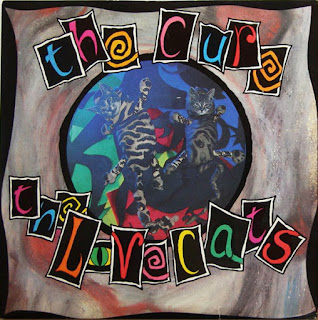THE CURE - THE LOVECATS
Estrena: 21 d'octubre de 1983
Llistes: Regne Unit: #7
"The Lovecats" és un senzill llançat de manera independent a l'octubre de 1983. Va ser el primer Top 10 de la banda al Regne Unit, arribant al número 7 a les llistes. La cançó també va assolir èxit a Austràlia, on va assolir el número 6 a principis de 1984. Més tard, "The Lovecats" va ser inclosa a l'àlbum de recopilació "Japanese Whispers", llançat el desembre de 1983.
"The Lovecats" combina elements d'amor uxori i una exploració estranya del jazz skiffle. La base musical destaca pel contrabaix prominent de Phil Thornalley, complementat pel joc de piano de Robert Smith i el seu inesperat talent per tocar acords de guitarra a l’estil de Django Reinhardt. Lol Tolhurst hi afegeix un toc inusual amb el seu vibràfon.
Robert Smith inicialment va escriure "The Lovecats" com una paròdia, i més tard se’n va distanciar. En una entrevista amb la revista Rock & Folk, Smith va expressar els seus sentiments: "'The Lovecats' està lluny de ser la meva cançó preferida: composada borratxo, vídeo filmat borratxo, promoció feta borratxo. Va ser una broma."
"The Lovecats" originalment tenia el títol com tres paraules separades, com es pot veure a la portada del senzill i a l'etiqueta del maxi-single de vinil. Hi ha hagut variacions en la forma de presentar el títol. La compilació de senzills "Standing on a Beach/Staring at the Sea" va llistar la cançó com "The Love Cats" a la caràtula i al CD, però com "The Lovecats" al llibret. Quan es va llançar l'àlbum de grans èxits el 2001, el títol es va estandarditzar com "The Lovecats".
El vídeo inclou escenes de nombrosos gats i un moment memorable on una gran pantalla cau sobre el cap del contrabaixista Phil Thornalley. El vídeo també mostra plans d'una mansió que la banda simulava estar interessada a comprar, però van retornar les claus l'endemà al matí. Inicialment, la banda tenia la intenció d'utilitzar gats reals per al vídeo, però van tenir dificultats i van optar per gats taxidèrmics. El vídeo presenta una mescla preliminar de la cançó enregistrada a París, diferent de la versió finalment llançada en vinil, que va ser enregistrada a Londres.
THE CURE - THE LOVECATS
Released: October 21, 1983
Charted: UK: #7
"The Love Cats" is a single released independently in October 1983. It marked the band's first Top 10 hit in the UK, reaching number 7 on the charts. The song also achieved success in Australia, where it peaked at number 6 in early 1984. Later, "The Love Cats" was included on the compilation album "Japanese Whispers," released in December 1983.
"The Love Cats" combines elements of uxorious love and a quirky Cure exploration into skiffle-ish jazz. The musical backbone features Phil Thornalley's prominent double bass, complemented by Robert Smith's slinky piano playing and his unexpected talent for bouncing Django Reinhardt-style guitar chords. Lol Tolhurst adds an unusual touch with his vibraphone playing.
Robert Smith initially wrote "The Love Cats" as a parody, and later distanced himself from the song. In an interview with Rock & Folk magazine, Smith expressed his feelings: "'The Love Cats' is far from being my favorite song: composed drunk, video filmed drunk, promotion made drunk. It was a joke."
"The Love Cats" was originally titled as three separate words, as seen on the single cover and twelve-inch label. There have been variations in how the title is presented. The singles compilation Standing on a Beach/Staring at the Sea listed the song as "The Love Cats" on the tray card and CD, but as "The Lovecats" in the booklet. When the Greatest Hits album was released in 2001, the title was standardized as "The Lovecats".
The music video includes scenes of numerous cats and a memorable moment where a large lampshade falls on bassist Phil Thornalley's head. The video also showcases shots of a mansion that the band jokingly pretended to be interested in purchasing, returning the keys the next morning. Initially planning to use real cats, the band encountered difficulties and instead opted for taxidermied cats. The video features an early rough mix of the song recorded in Paris, distinct from the version eventually released on vinyl, which was recorded in London.









Cap comentari:
Publica un comentari a l'entrada